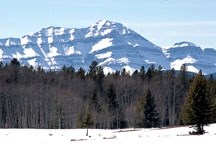A high snow pack and warmer temperatures have local and provincial officials on the watch for potential flooding.
The Province sent out stream flow advisories last week stating higher temperatures could cause a rapid snowmelt, warning this could cause localized flooding in some areas across Alberta.
The snow pack on Mount Odlum, at the headwaters of the Sheep River, is above the average of 449mm snow-water equivalent and higher than the normal historic range. This year’s snow pack is higher than in 2007 when minor flooding occurred in the river valley.
However, according to Okotoks deputy fire chief Jim Smith the main concern is not the amount of snow but how quickly it will melt.
“We’ll keep an eye on it, but the thing with snow pack is you have to worry about the weather,” he said. “If it gets really, really warm then we’ll have something to worry about.”
Smith said a slower melt will reduce the potential of any flooding.
The snow pack is a concern, but Smith said rain is usually a larger contributor to flooding than snow.
“It depends on the rain, but it also depends on the amount of snow that comes down the Sheep as well,” he said.
The flood of 2005 was the result of heavy rainfall in June of that year, not snow pack. Snow levels for much of the upper Highwood basin, which includes the Sheep River, were below average in 2005.
Smith said the department is keeping an eye on conditions and firefighters will be doing some training in the coming weeks to be prepared in the event of flooding.
“We’re preparing, doing river rescue and swift water rescue training,” he said. “Next month we’ll do flood training, sand bagging, diking and pumping.”
Alberta Environment’s spring runoff forecast for most of southern Alberta is much above average.
Alberta Environment spokesperson Chris Borbeau said it’s difficult at this time to forecast flood risk for later in May or June.
“The further you get out the more of a challenge it is to accurately predict what kind of situation may be,” he said.
Borbeau said flooding in those months is usually more of a result of rain, which is difficult to predict in advance.
“You have soil moisture, as well, is another factor and the big one is precipitation,” he said. “The types of precipitation you need to have a major flooding event is an intense storm.”




